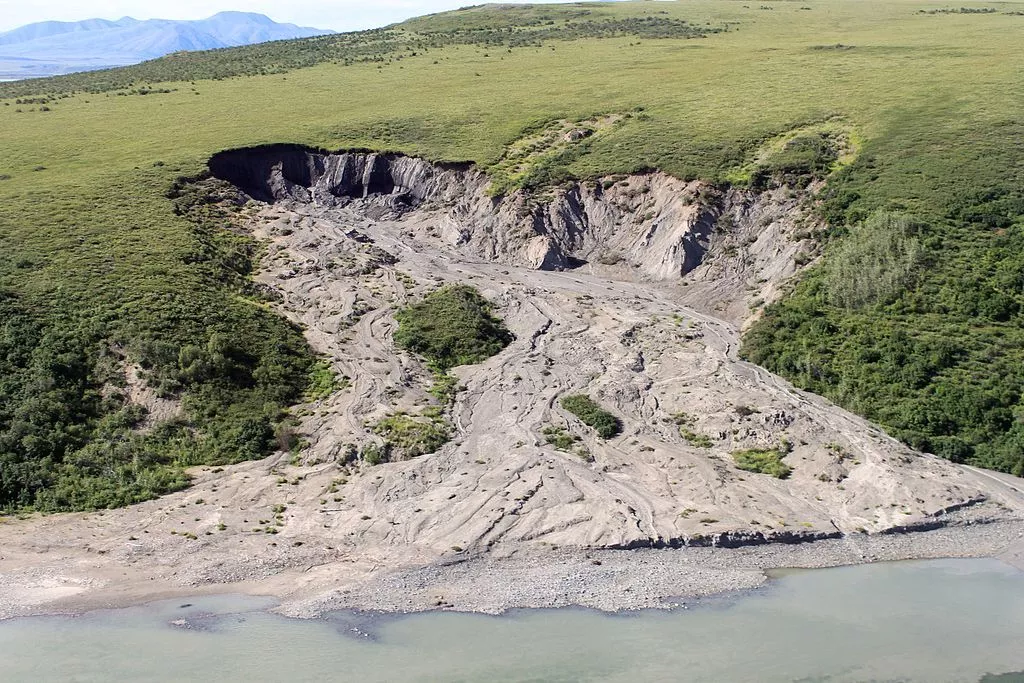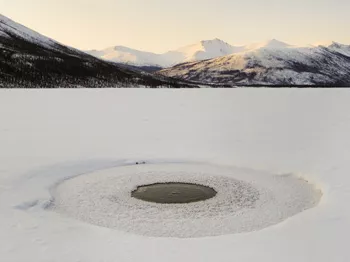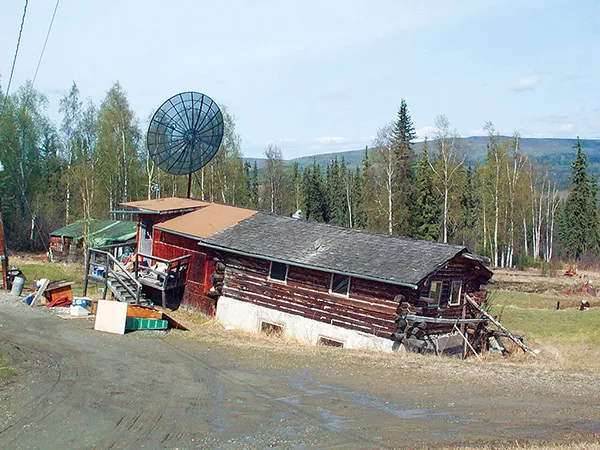Permafrost, also known as frozen ground, is soil that remains at or below 0°C (32°F) for at least two years. When it thaws, permafrost contributes to global warming by releasing greenhouse gases into the atmosphere.
A breakdown of decomposition
In permafrost regions, the topmost layer of the soil—the active layer—thaws enough in summer to sustain plants and feed animals. In permafrost active layers, as in the rest of the world, when plants and animals die, their remains end up in the soil.
When conditions are warm enough, soil microbes break down dead organisms, separating their carbon-rich remains into chemical components. Some of these are nutrients, such as nitrogen, which boost future plant growth. Often, the microbes convert carbon into carbon dioxide (CO2), but in situations with high moisture and low oxygen, the microbes convert carbon into methane (CH4).
When conditions are too cold for microbes to carry out these functions, frozen ground can hold the undecomposed remains of plants and animals for hundreds or even thousands of years. But if permafrost thaws, the microbes wake up and get to work.
A massive reservoir of warming
The amount of carbon stored in permafrost regions of the Northern Hemisphere is estimated at almost twice the amount of carbon currently contained in Earth’s atmosphere. Today’s underground carbon may be tomorrow’s carbon dioxide or methane.
Carbon dioxide and methane are greenhouse gases because their molecular composition has the ability to absorb heat radiated from our planet’s surface, and throw some of that heat right back to Earth. Carbon dioxide can linger in the atmosphere for thousands of years. Methane has a shorter but arguably more effective lifespan. It lasts only about a decade, but it has a much greater global warming potential than carbon dioxide, up to 84 times its strength over 20 years.
If just 10 percent of the carbon estimated to reside in permafrost were to be released, that carbon would equal all the greenhouse-gas emissions currently caused by land-use changes—not all anthropogenic emissions, but all emissions associated with land use. That figure is estimated at over a billion metric tons per year.
Scientists studying permafrost thaw fear a vicious cycle of warming. Greater amounts of atmospheric greenhouse gases raise temperatures leading to further permafrost thaw. Continued thaw releases more greenhouse gases, and the process continues.
Ancient trouble bubbles up from below
Under the right conditions, thawing permafrost forms hot-off-the-press methane from carbon-rich detritus. But permafrost also stores old methane that formed long ago. Trapped, it waits for an escape.
In 2008, Katey Walter Anthony, an aquatic ecosystem ecologist at the University of Alaska, observed methane seeping out of lakes on the Alaskan tundra. Methane can reside in and beneath the permafrost overlying the Arctic’s sedimentary basins. It is common in the organic material deposited by glaciers, and in marshy lakes and ponds. When permafrost thaws beneath Arctic lakes, gas-permeable chimneys open up, and methane leaks out.
Walter Anthony and her team investigated these large methane seeps, discovering more than 150,000. During ground surveys, they examined the chemical and isotope composition of the bubbling methane to determine the source. In many of the smaller bubbling seeps, methane was newer—formed when plants and other organic material decayed in the lakes. But the researchers also found that the biggest seeps were not releasing newly minted methane. Instead, they were releasing methane from ancient sources: natural gas and coal beds formed by organisms that decomposed long ago. These ancient sources had remained underground for tens of thousands of years. So, permafrost is now thawing to such an extent that it is oozing ancient gases.
Melting past model predictions
Permafrost not only holds in carbon that can otherwise turn into greenhouse gas, permafrost also props up the land itself. Permafrost’s effectiveness in this role is most notable when it stops working.
Researchers revisiting permafrost regions can find lakes where there used to be trees, and sediment-clogged rivers where the water used to be clear. Permafrost thaw can even lead to landscape changes as dramatic as craters and landslides as warming soils rapidly slump and liquefy.
Besides skewing bridges, cracking roads, and breaking buildings, these slumps accelerate thaw.
Historically, climate models have assumed a gradual thawing of permafrost, with decades or centuries passing before deep layers of frozen soil warmed enough to release carbon. When land suddenly slumps or slides, significant amounts of permafrost, previously buried tens of feet below the surface, are exposed to faster thawing. Exposure to sunlight can quickly convert ancient organic carbon to carbon dioxide, a phenomenon not yet reflected in many climate models. As a result, current projections of greenhouse gas release by thawing permafrost—and the feedback loops of further thaw—may be underestimated.
Shifting the balance of carbon
Warming at high latitudes thaws permafrost (releasing carbon), but it also prompts plant growth (sequestering carbon). Most of the sequestration happens during the brief summer growing season, and more carbon is released at other times of year.
Which of these processes—sequestration or release—is currently winning “is an area of intense research,” according to the 2019 Arctic Report Card. Although studies have not all agreed on whether permafrost regions are predominantly carbon sources or sinks, the Arctic Report Card described research indicating that the circumpolar regions are becoming a net source of carbon.
References
Bowen, J.C. et al. 2020. Arctic amplification of global warming strengthened by sunlight oxidation of permafrost carbon to CO2. Geophysical Research Letters 47(12): e2020GL087085, doi:10.1029/2020GL087085.
Cory, R.M. et al. 2013. Surface exposure to sunlight stimulates CO2 release from permafrost soil carbon in the Arctic. Proceedings of the National Academy of Sciences of the United States of America 110(9), doi:10.1073/pnas.1214104110.
Moon, T. et al. 2019. The expanding footprint of rapid Arctic change. Earth's Future 7:212-218. doi:10.1029/2018EF001088.
Myhre, G. et al. 2013. Anthropogenic and natural radiative forcing. In: Climate Change 2013: The Physical Science Basis. Contribution of Working Group I to the Fifth Assessment Report of the Intergovernmental Panel on Climate Change. Cambridge University Press, Cambridge, United Kingdom and New York, NY, USA
Schuur, T. 2019. Permafrost and the Global Carbon Cycle. Arctic Report Card: Update for 2019. https://arctic.noaa.gov/Report-Card/Report-Card-2019/ArtMID/7916/ArticleID/844/Permafrost-and-the-Global-Carbon-Cycle.
Turetsky, M.R. et al. 2019. Permafrost collapse is accelerating carbon release. Nature 569: 32-34. doi:10.1038/d41586-019-01313-4.
Walter Anthony, K. 2009. Methane: A menace surfaces. Scientific American 301: 68-75.


